Most of us are still trying to get our arms around 5G wireless technology and all that means throughout the communications network. Yet, it’s essential to keep up with what’s coming next — 6G. This article discusses the what, the why, and the when of this upcoming wireless network standard.
What Is 6G?
6G is sixth-generation wireless. It’s designed to use higher frequencies, provide higher capacity, and support micro-second latency. It’s expected to facilitate huge improvements in imaging, location awareness, presence technology, and even use artificial intelligence to determine the best location for computing tasks. And that’s just the starting point.

What Are the Frequencies and Speeds of 6G?
We’ve provided the list below of the differences from the third-generation or 3G up to and including the sixth-generation or 6G wireless.
Frequency Spectrum
- 3G — up to 2.1 Gigahertz (GHz).
- 4G — up to 2.5 GHz.
- 5G — up to 6 GHz for range one, up to 54 GHz for range two.
- 6G — 95 GHz to 3 Terahertz (THz) or 3,000 GHz.
Network Speeds
- 3G — from 3 to 7 Megabits per second (Mbps).
- 4G — approximately 33 Mbps.
- 5G — 40 to 1,100 Mbps.
- 6G — Up to 1 Terabits per second or 1,000,000 Mbps.
You can readily see the significant differences in each wireless generation. With 6G, the frequencies are in the millimeter-wave range. And the speeds are simply phenomenal. The higher frequencies support wider bandwidth signals, which is the underlying reason for faster data transmission speeds.

Why Go to 6G?
For starters, everything that can be accomplished with 5G can be done with 6G. And as 6G is rolled out, it will need to include the existing 5G network, as is being done now 4G and the 5G rollout.
We touched on small cell usage and its enhanced connectivity earlier.
This will be expanded significantly with the higher frequencies and bandwidth of 6G. Many feel that this next generation will allow direct device-to-device connections, essentially bypassing the rest of the wireless network. This will increase speeds and drastically drop latency.
We also wrote about wireless needs in transportation, where tracking everything in real-time is crucial to overcoming supply chain challenges. All this will be developed extensively over the next few years under 5G while ramping up for incredible breakthroughs in 6G.
One breakthrough will be edge computing, which takes network management away from centralized cloud computing to localized devices. This, in turn, makes everything work much more quickly based on reduced response time. That reduced response time, also known as low latency, truly brings automated drone deliveries into reality.
Likewise, virtual reality could bring those sci-fi images of teletransporters to our day and age. Think about standing next to the person you’re talking with who’s actually in another country. It would make today’s video calls pale in comparison. In that type of VR environment, gaming would go to an entirely new level.
This type of networking could also bring about remote surgery or even connected implants or brain-to-computer interfaces. The advances in helping the disabled could be incredible. As you can tell, the Internet-of-Things will eventually move those sensors and computing devices inside your body.
Read more in our blog: The Role of Fiber Optic Cables in the USA Cell Tower Infrastructure

When Will 6G Be Available?
The exact standards for 6G wireless are still being determined. Yet several organizations and governments are working on early applications. China has put a 6G satellite into orbit. There’s a 6G flagship project in Finland. Japan has launched a significant initiative, and both Vodafone in Germany and Samsung in South Korea are working on the technology.
We’ve outlined the development and deployment timeframes for the previous wireless generations and projections for 6G below.
Development and Deployment
- 3G — 1985 develop tech standards, 2000 deployment.
- 4G — 2000 develop tech standards, 2012 deployment.
- 5G — 2012 develop tech standards, 2020 deployment.
- 6G — 2020 develop tech standards, 2028 deployment.
As you can see, the pace of development of each new standard is increasing. The 15 years from development to deployment for 3G has now become eight years for 5G with the same timeframe expected for 6G. Of course, as we see with 5G, deployment starts slowly and then accelerates as the infrastructure reaches critical mass. 2028 deployment is probably optimistic, but you can certainly expect to see things happening in the 2030 timeframe.

What Are the Implications for Cables and Connectivity?
Data centers and cellular networks are already working overtime to bring businesses 5G speeds and bandwidth. We’ve seen demand for fiber optic cables, hybrid cables, and networking cables jump to make all this happen. And the required specifications continue to move upward.
We expect to see this same expanding demand and need for higher and higher performance to move off the launch pad like a rocket ship. Higher performance means higher bandwidths and speeds, lower loss, and multiples of installations, just as with 5G only more so.
We’re confident in our ability to meet those growing needs, just as we are currently meeting needs for 5G networking.
We Can Help
In your current projects, if your requirements are already specified and ready for a quote, we are prepared to meet your deadlines and pricing targets. Our extensive in-house services and advanced manufacturing capabilities are in place to meet your requirements.
We offer much more than state-of-the-art manufacturing. Our dedicated team is also known for going to great lengths to meet the needs of our customers, including working round-the-clock to meet tight turnaround time requirements.
Our sales representatives are standing by to assist you with product questions and quotes Monday – Friday, 8:00 am to 5:00 pm Eastern. You can also send us an email or complete our contact form, and we’ll get right back to you.




